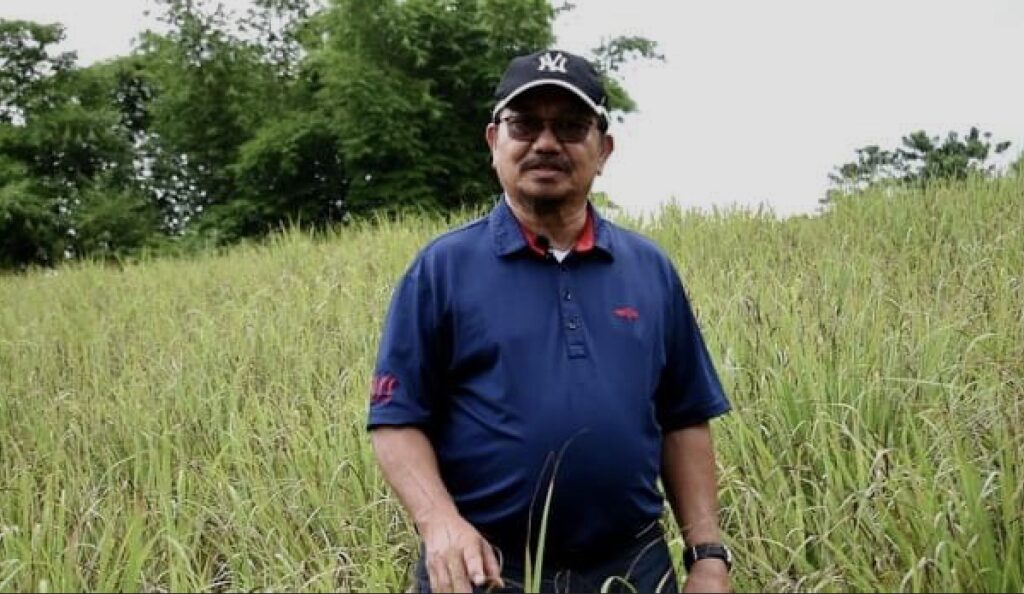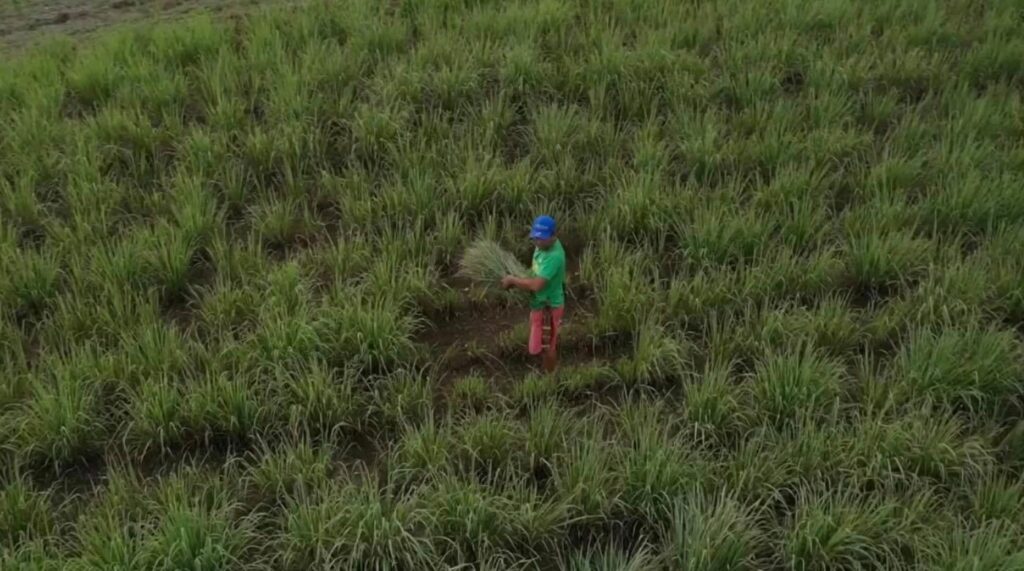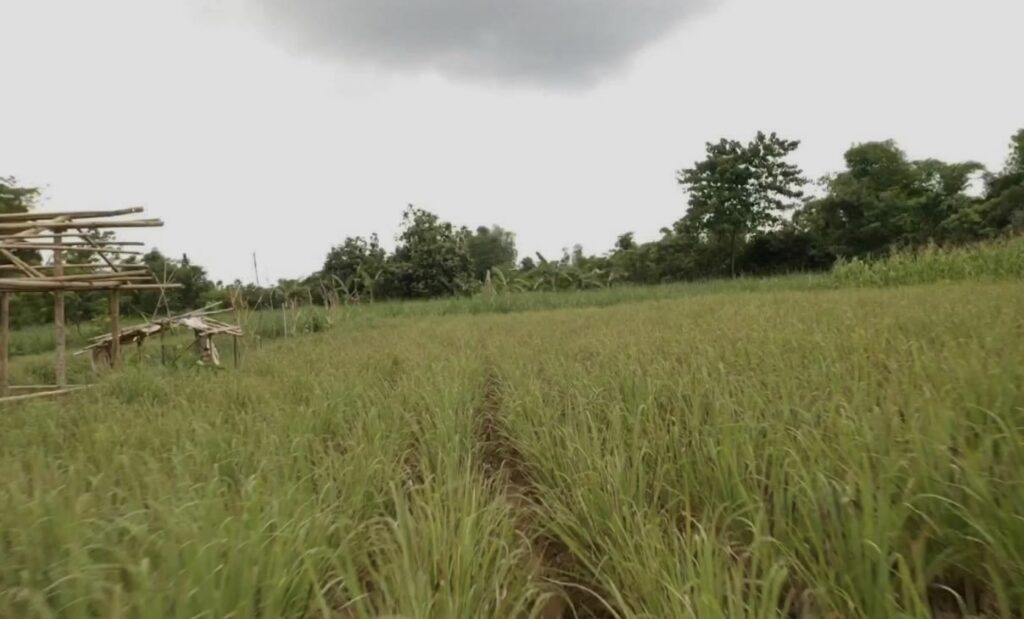By Henrylito D. Tacio
Photos from the Facebook account of Secretary Emmanuel Pinol
Lemongrass comes in various names: barbed wire grass, silky heads, citronella grass, camel’s hay, cochin grass, and fever grass. In French, it is known as herbe de citron, while Indians call it bhustrina or sera. In Thailand, it is known as takra, while Filipinos simply call it tanglad. Scientists have given the name Cymbopogon citratus for it.
Most Filipino farmers neglect this crop as it can be grown anywhere and is a common backyard plant. What they don’t know is that the crop can be turned into a profitable venture.
That was what Emmanuel Piñol found out when he visited the mountains of Murcia in Negro Occidental recently. The head of Mindanao Development Authority (MinDA) wanted to replicate the technology in the country’s second-largest island to help “improve the lives of our people.”
His MinDA team and a farmer leader from Bukidnon were brought by Auke Idzenga, a recipient of the prestigious Ramon Magsaysay Award in 2011, to a mountain village to check on more than a decade ram pump system, which provides water to farmer households in Sitio Ananggue, Buenavista.

“I discovered that the ram pump system does not just provide water to a village of about 45 households but livelihood and hope, as well,” Piñol wrote of his experience that was posted in his personal Facebook account.
According to Piñol, the water from the ram pumps is used to cultivate and process lemongrass, which is planted in the mountain village.
“Instead of bringing down the harvested lemon grass, Auke and his Alternative Indigenous Development Foundation, Inc., established an oil processing facility right in the village powered by burning bamboo or wood,” the MinDA chief reported.
The Australian government has extended P1-million development assistance, and the farmers are now building a concrete structure to serve as their processing facility, laboratory, and office.
The lemongrass oil which the farmers produced is sold at P2,500 per liter. Another product, called hydrosol – the healthy water produced during the distilling process – is sold for P3,000 per plastic jar.

According to Piñol, lemongrass oil is used as the main ingredient for massage oil and cooking and food flavoring. The hydrosol, on the other hand, could be mixed with natural water or coffee.
Last year, the Davao Investors Association reported that there’s a huge demand for lemongrass oil for cosmetic purposes in South Korea and Europe.
Aside from being a profitable crop, planting lemongrass in upland areas also has another benefit. Lemongrass helps prevent soil erosion since only the leaves are harvested.
“Since the mother plants are allowed to ratoon or regrow, the roots hold the soil preventing soil erosion,” Piñol said.
This is good news. Estimates from the Department of Environment and Natural Resources (DENR) showed about 10,000 cubic meters of arable soil per hectare are eroded annually. Such an amount is equivalent to one -meter layer of soil thickness removed per hectare per year.
“Without soil, there would be no food apart from what the rivers and seas can provide,” said Edouard Saouma, former head of the UN Food and Agriculture Organization. “The soil is the world’s most precious natural resource. Yet, it is not valued as it should be. Gold, oil, minerals and precious stones command prices which have led us to threat soil as mere dirt.”

Harold Ray Watson, an agricultural missionary who used to direct the Mindanao Baptist Rural Life Center and a recipient of the Ramon Magsaysay Award for international understanding in 1985, considered soil erosion “an enemy to any nation.”
“(Soil erosion is) far worse than any external enemy coming into a country and conquering it because erosion is an enemy you cannot see vividly,” Watson said. “It’s a low creeping enemy that soon possesses the land.”
Going back to lemongrass. According to Auke, the lack of knowledge on lemongrass oil and hydrosol benefits prevents farmers from expanding because of its limited market.
“It’s a niche market so we could not expand because it would saturate the market and depress prices,” Auke said.
If only given the much-needed exposure in terms of its benefits and its contribution to environmental protection, Piñol believes “lemon grass oil and hydrosol would gain popularity and create a bigger market.”
What most Filipinos don’t know that lemongrass is good for those with Type 2 diabetes.
“About 95% of Filipino diabetics have Type 2 diabetes, mainly caused by lack of exercise and poor diet,” wrote Irene M. Villaseñor and June Marco B. Gonzales, authors of a paper published by the Department of Science and Technology (DOST).
The website of Organic Facts, organicfacts.net, gives this bit of information: “Lemon grass has been proven beneficial in treating Type 2 diabetes. Studies have shown that the citral present in it helps maintain optimum levels of insulin and improves the tolerance of glucose in the body.”
Another website, healthyeating.sfgate.com, reported: “A study published in the Journal of Ethnopharmacology in 2007 looked at the impact of administering lemon grass to rats. After 42 days of taking 125 to 500 milligrams of lemon grass per kilogram of body weight once a day, the rates had improved fasting glucose levels.”
The study said that based on the results, the researchers claim that “lemon grass may help to treat or prevent diabetes” but added that “more research is needed to evaluate the safety and effectiveness for humans.”
One of the best ways to serve lemongrass is in the form of tea. The following are needed: clumps of lemongrass, one cup of water, and coconut sugar to taste. The outer layer of lemon is peeled and discarded. The peeled, clean leaves are boiled for 5 to 7 minutes. Coconut sugar may be added if required. Once done, the boiling water is poured into a cup and stirred before drinking it hot.
Lemongrass is commonly used in teas, soups, and curries. The oil is used as a pesticide and preservative. The aromatic herb is used in the Caribbean and many types of Asian cooking and has become very popular in the United States.
But one good thing about lemongrass is that it has been under study for its medicinal purposes. Lemongrass has 65-85 percent citral that contains active ingredients like myrcene, citronella, citronellol, and geraniol. Citral is a mobile pale-yellow liquid used in perfume, and as a flavoring, it can also be found in lemon peel.
In some countries like Malaysia and those in Central America, lemongrass is cultivated for its oil (which is used in pharmaceutical preparations and skincare products). The Book of Herbs, authored by Dorothy Hall, said lemongrass contains vitamin A and is good for “those who wish to have bright eyes and a clear skin.”
Lemongrass has “many uses in folk or traditional medicine in many different cultures, and is a common home remedy for many ailments,” wrote the Asian Hospital and Medical Center (AHMC), which described lemongrass as “more than a kitchen condiment.”
For one, lemongrass has a detoxifying effect. “Lemon grass has been known to have a detoxifying effect on the body’s digestive system, specifically the pancreas, liver, kidney, and bladder,” the AHMC said. “The herb is said to help lower levels of uric acid, cholesterol, and other toxins in the body. In addition to this, it can help stimulate digestion. As a result, lemon grass can help prevent gastroenteritis and indigestion. The herb has also been known to promote blood circulation. People who suffer from high blood pressure may find that drinking lemon grass tea can reduce blood pressure.”
Regarding the antimicrobial properties of lemongrass, a study published in the Journal of Contemporary Dental Practice in 2012 found that an oil extract from lemongrass inhibited streptococcus bacteria’s growth in the laboratory.
Lemongrass is also a good mouthwash. Two tablespoonfuls of chopped leaves are soaked in one glass of hot water for 30 minutes. The infusion is strained first before being used as a mouthwash.
How good is lemongrass in controlling cholesterol levels? A study done by the University of Wisconsin in 1989 found that people with high cholesterol who took 140-milligram capsules of lemongrass oil daily noticed a reduction in cholesterol levels. “They also experienced a significant decrease in blood fats,” the study said.
Like most herbs, lemongrass has some drawbacks. “Some people can experience food allergy symptoms after eating lemon grass, although this effect is fairly unusual,” wrote Joseph McAllister in an article published by Livestrong. “Individuals who are vulnerable to lemon grass allergies may experience an itchy skin rash or hives on the skin after eating lemon grass, as well as chest pain and constriction, throat swelling and difficulty breathing.”
There are also some precautions in using lemongrass oil. “People who are diabetic or hypoglycemic should avoid its application because the oil can reduce your blood glucose levels and is not recommended for people already on anti-diabetic and anti-hypertensive medications,” the website newhealthadvisor.com states. “Children, pregnant women or nursing mothers should not use the oil orally. People suffering from liver or kidney disorders should consult their physician first before using the oil.”
(Photos were taken by the MinDA Media Team in Sitio Ananggue, Buenavista, Murcia, Negros Occidental)

